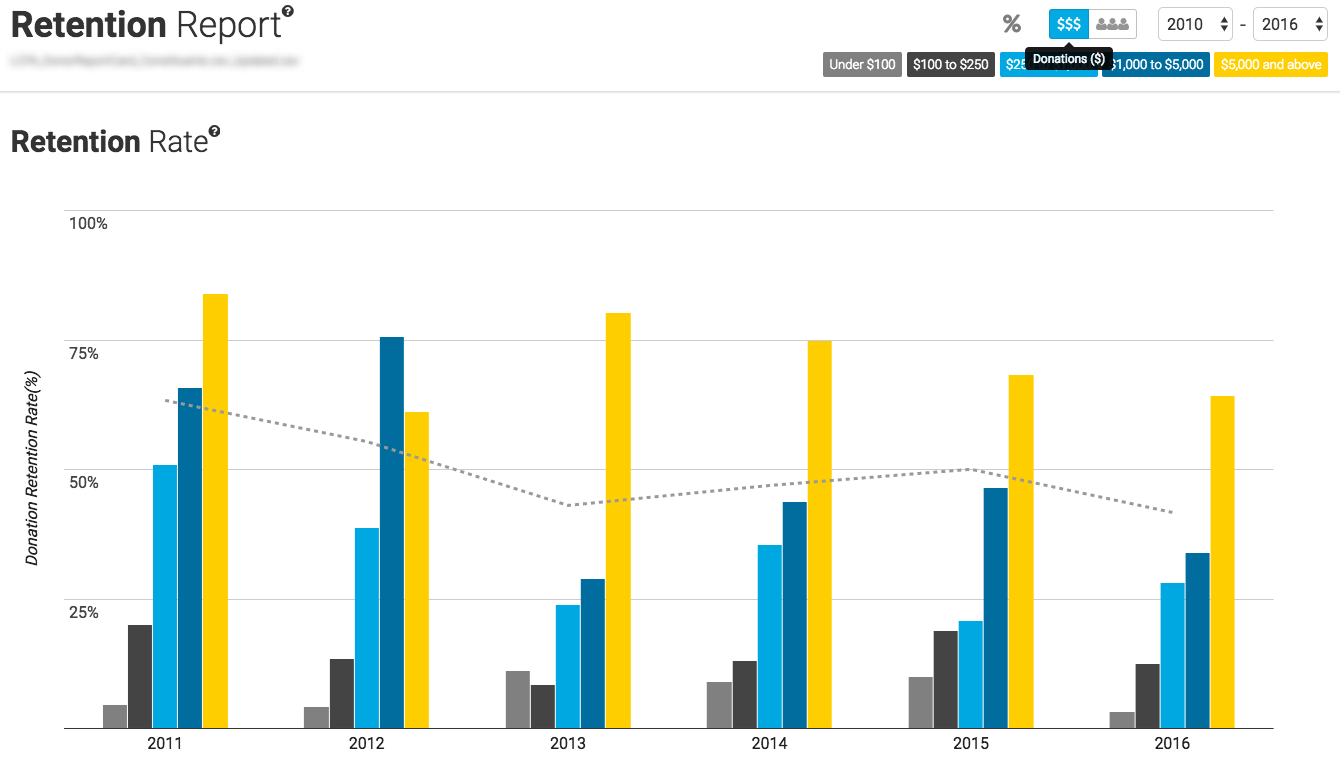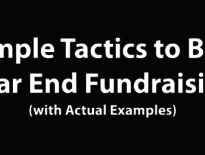Welcome to the second edition of our new series Metrics 101. In these Metrics 101 articles we define fundraising metrics, outline analysis tips, and highlight different ways you can take data and present data to your colleagues, leadership and the board. Today we will cover donation retention and donor retention.
In our first installment we covered the most basic fundraising metric: donor and donation growth. Today we are going to focus on another simple, but unbelievably important set of metrics: donor and donation retention rates. We will put more emphasis on the latter.
When it comes to measuring fundraising effectiveness you need to measure retention. If you aren’t sure why retention is important I’d recommend you take a look at this article, which explains the importance of finding a balance between donor acquisition cost and donor lifetime value. Or, simply do a Google search on the importance of donor retention to get up to speed.
What are donor and donation retention rates?
Defining retention is simple: it is the number of ($) donations or (#) donors from last year (quarter, month, week, etc.) who gave again this year (quarter, month, week, etc.) to your organization.
Retention rates are simply calculated by taking the retained ($) donations or (#) donors and dividing them by the total amount of ($) donations or (#) donors at the beginning of that period.
Simply put, donor retention rate is the number of donors you manage to keep by the end of the year with respect to the number you had at the start of the year. And, donation retention rate is the amount of donation revenue you manage to keep by the end of the year with respect to the amount you had at the start of the year.
Just like any for-profit business, you’ll want to retain as many customers/donors (and their donations) as you can year-over-year. Ideally, every new donor your organization acquires will be retained in the following year. Unfortunately all nonprofits, just like their for-profit counterparts, they experience attrition or lapse (donors who do not renew with the organization).
Donor retention answers the question, “did donor ID 12345, who made a donation last year, make another donation this year?” If the answer is yes, then the donor was retained. If the answer was no, then the donor lapsed.
Donation retention focuses solely on donation renewal values – the dollars that renew. Donation retention answers the question, “did donor ID 12345, who made $500 in donations last year, make $500 in donations this year? Did they make only $100 in donations? Did they contribute $1,000 in donations?” If the donor made contributions of equal value to the previous year, then their donation retention rate is 100%. If the donor decreased their donation amount year-over-year, then their donation retention rate will be below 100%. Finally, if the donor’s donation amount increased year-over-year, then their donation retention rate will be greater than 100%.
When looking at donor and donation retention rates you’ll want to shy away from analyzing one constituent at a time. Instead, what will be more valuable is analyzing your entire database or a large segment of our donors. This way you can see trends, analyze giving behavior and optimize future fundraising performance.
A few things you need to understand
Donor retention rate is capped at 100% — the maximum number of donors you can renew year-over-year is 100% of the existing donors you have.
Donation retention rate on the other hand is theoretically unbounded. Donation revenue renewal rates could be much greater than 100%. If all of your donors renewed and upgraded their donation amounts your rate would be greater than 100%. It could also be much lower than your donor retention rate if a lot of your donors renew but downgrade their donation amounts.
Why is donation retention rate important?
Our industry has focused a lot of attention on donor retention rates, and for good reason. Take a look at CauseVox for more material that dives deeper into donor retention. Donor retention is relatively easy to understand and doesn’t take too much effort to comprehend.
Unfortunately, no one has taken the time to expand on the importance of donation retention rates. The Fundraising Effectiveness Project brought this metric to light in their Fundraising Fitness Test, but accessing and comprehending that information can be really difficult. Fortunately, with the fundraisingreportcard.com you can get your donation retention rate calculated in just a few seconds.
This is important for a few reasons. Although the concept of revenue renewal rates is a little more complex, it is more telling of overall fundraising performance.
Donation retention rate can be an eye opening metric that speaks volumes to your constituents behavior. When comparing donor retention rate and donation retention rate you can start to infer how your retained donors are interacting with your organization. Are they upgrading, downgrading, etc.
We all know it is great to retain a donor year after year-after-year. But, imagine a scenario where donor retention rate is rising year-over-year and donation retention is falling. Donors are sticking around, but consistently decreasing their annual donation amount. That increasing donor retention rate is misleading. Donation retention tells a more true story of what is going on with your constituents.
In a perfect world your donation retention rate should outpace your donor retention rate. Aka, retained donors are upgrading their giving, donating more year-over-year to your organization. Yet, a lot of the organizations I have the pleasure of working with either disregard donation retention rate, don’t calculate it at all, or don’t know what it is.
Who cares if you retain 90% of your donors if they all downgrade their contributions?! That’s like a retail store that keeps getting repeat customers but they consistently buy less and less. Eventually that shop will go out of business. The same idea applies to our sector and fundraising effectiveness.
How do you calculate donation retention rate?
Before we get into the donation retention rate equation, I want to mention that the fundraisingreportcard.com will calculate this for you on your retention report. If you insist on doing this by hand then follow along below.
To calculate donation retention rate, you first need to calculate your retained donation amount and your total donation amount.
Your donation retention rate equation will look something like this:
2016 Donation Retention Rate = 2016 retained donation amount ÷ 2015 total donation amount
The key part of our equation is our denominator, the bottom part of the fraction. 2015 total donation amount represents the benchmark amount of dollars able to be retained during the next year. For example, if your organization had total donation revenue of $1,000,000 in 2015 and you have 2016 retained donations of $1,000,000 you would have a 100% donation retention rate. If your retained donation amount in 2016 was $1,500,000 you would have a donation retention rate of 150%. Remember, donation retention rate is unbounded. You can theoretically receive an infinite amount of donations from retained donors, which can be greater than total donations from a previous year.
If you have access to your CRM or database I’d recommend you simply pull the three fields of data you need for the fundraisingreportcard.com and let it calculate these metrics for you. If you’re going to give this a shot on your own you’ll need to dedicate a few hours or days to work in Excel.
How do I use donation retention rate?
Leveraging donation retention rate comes down to analysis. A lot of Fundraising Report Card® users have shared stories with us about their experience in upgrading existing donors to boost donation retention rate.
Measuring, tracking and visualizing donation retention rate is a great way to make sure your retained donors are being upgraded year-over-year. Many fundraisingreportcard.com users use donation retention rate as one of their key performance metrics they will measure and set goals for each year.
For example, one organization we work with mentioned that after studying trends in their donation retention rates, they will be pursuing targeted upgrade appeals to retained donors. They set a goal of increasing their donation retention rate by 5% from the prior year.
The other feedback we get from users is that donation retention rate can be more easily understood with the help of charts and graphs.
Percentages and numbers mean a lot, but for most people, looking at graphs and visualizations are easier to comprehend. When it comes to looking at donor growth rates we all know that 5% retention is bad and 90% is good. But having a graphical representation makes the point all the more clear. It can also help you identify trends over longer periods of time as well.
Calculating donor & donation retention rates and more with a single click
If the thought of calculating donor and donation retention rates (or any other fundraising metric for that matter) by yourself is daunting, check out the Fundraising Report Card®. We provide one-click, simple-setup fundraising analytics & insights.






3 thoughts on “Metrics 101: Donor & Donation Retention”